Features of Radiative Mixed Convective Heat Transfer on the Slip Flow of Nanofluid Past a Stretching Bended Sheet with Activation Energy and Binary Reaction
Abstract
:1. Introduction
2. Description and Mathematical Modeling of the Problem
- Incompressible flow;
- Steady flow;
- Buoyancy flow (opposing and assisting flows);
- Permeable bended stretching sheet;
- Slip velocity;
- Nanofluid;
- Boundary-layer approximation;
- Boussinesq approximation.
3. Solution Methodology and Verification of the Code
4. Discussion of the Results
4.1. Interpretation of Velocity Profiles
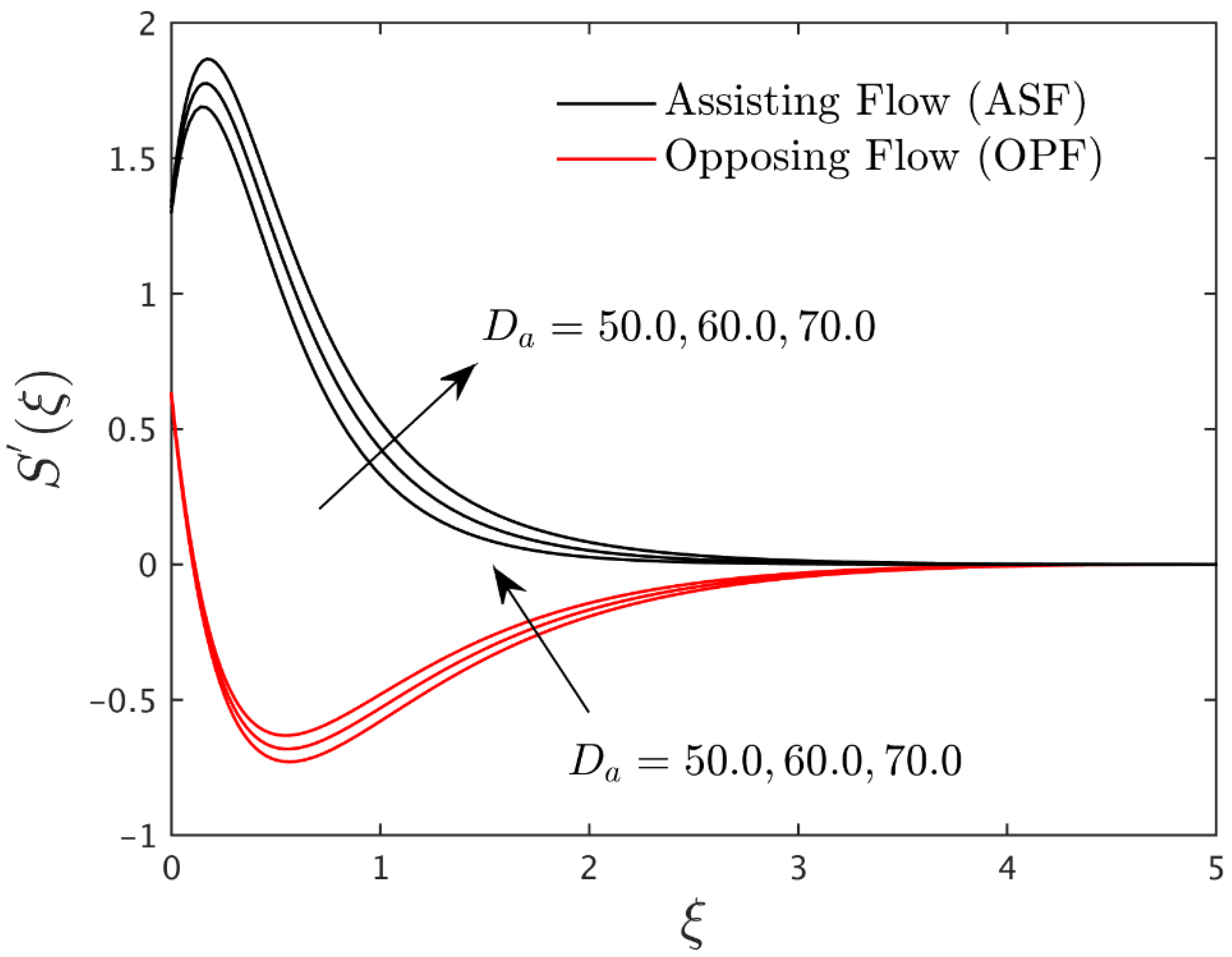

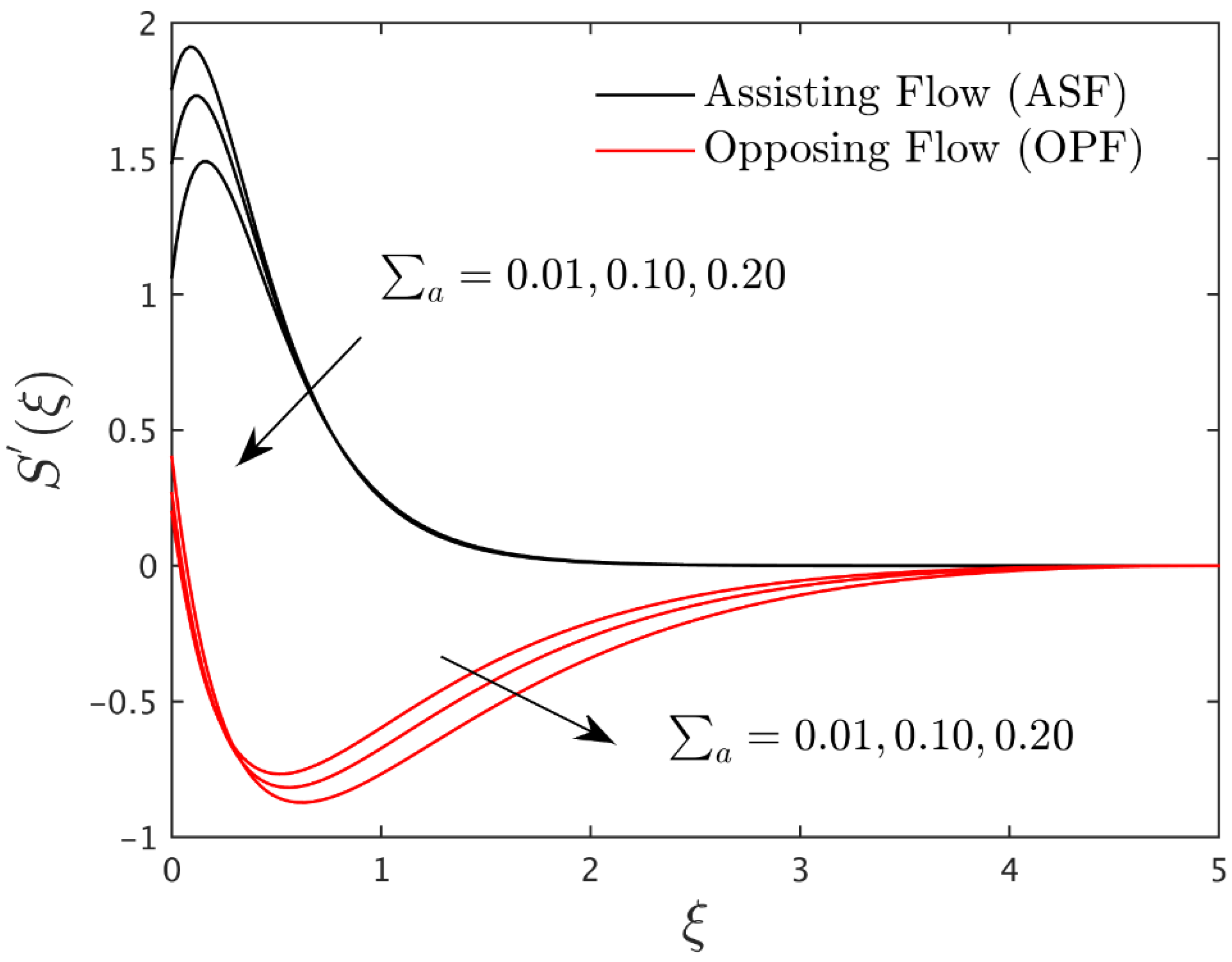
4.2. Interpretation of Temperature Profiles


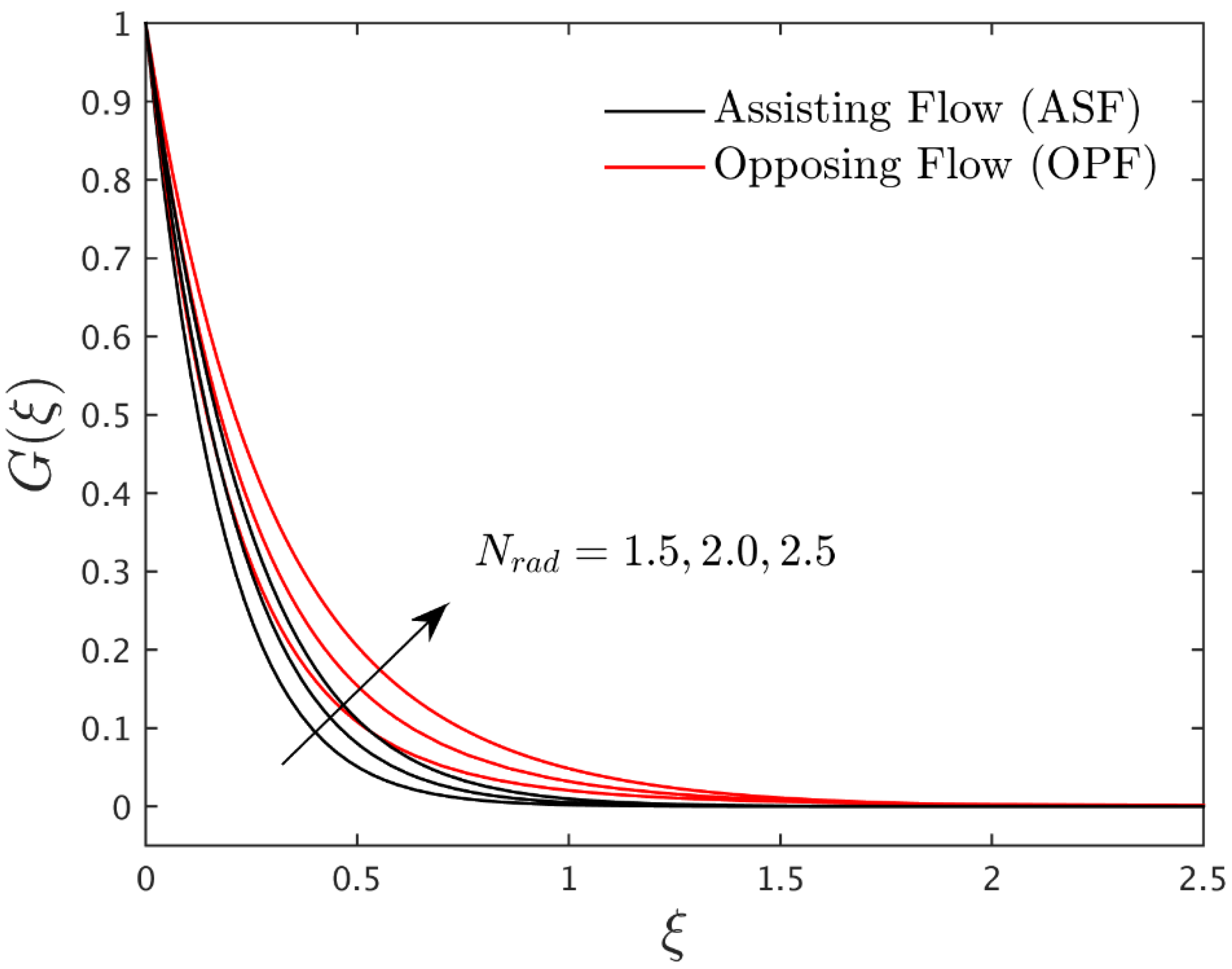
4.3. Interpretation of Concentration Profiles
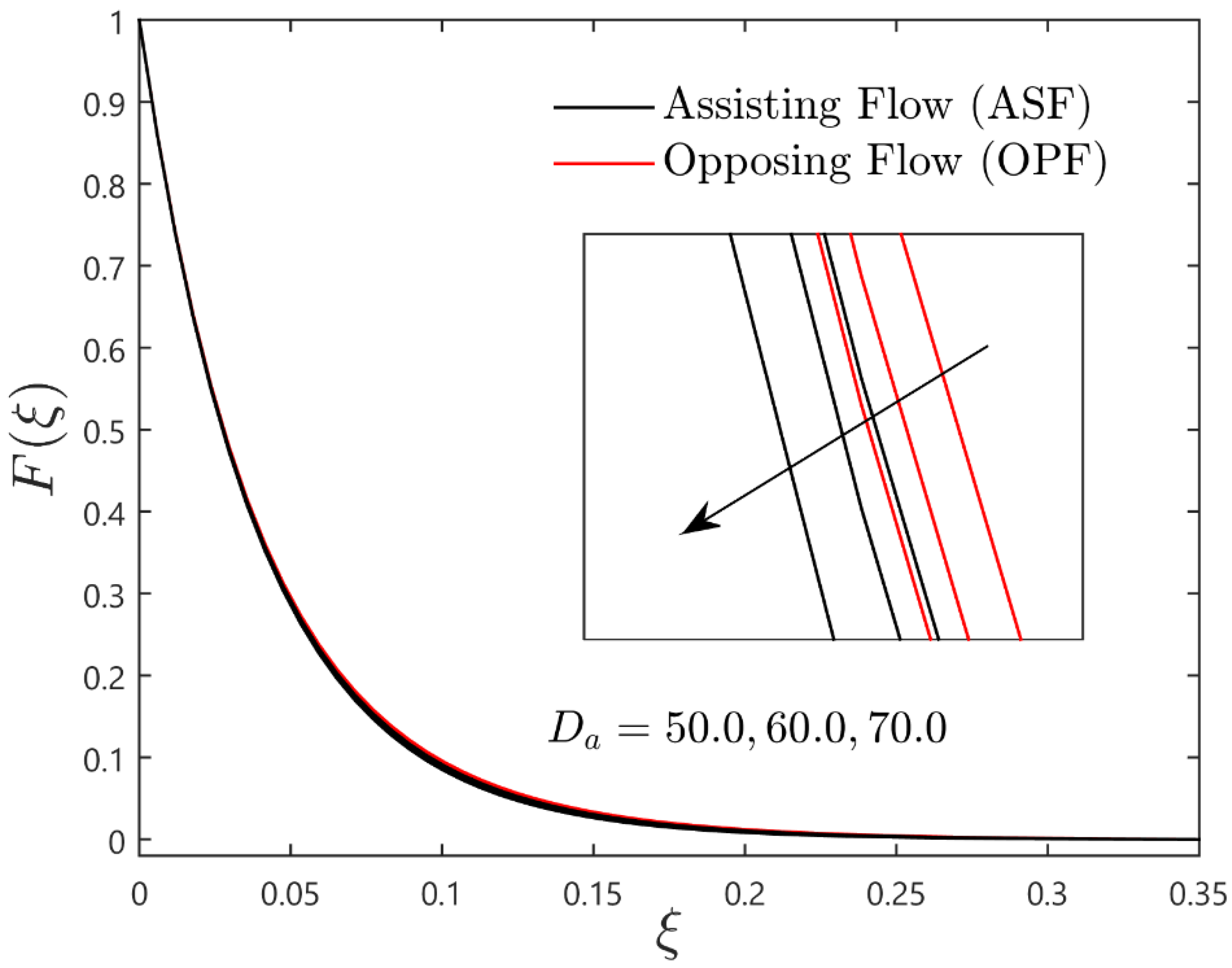
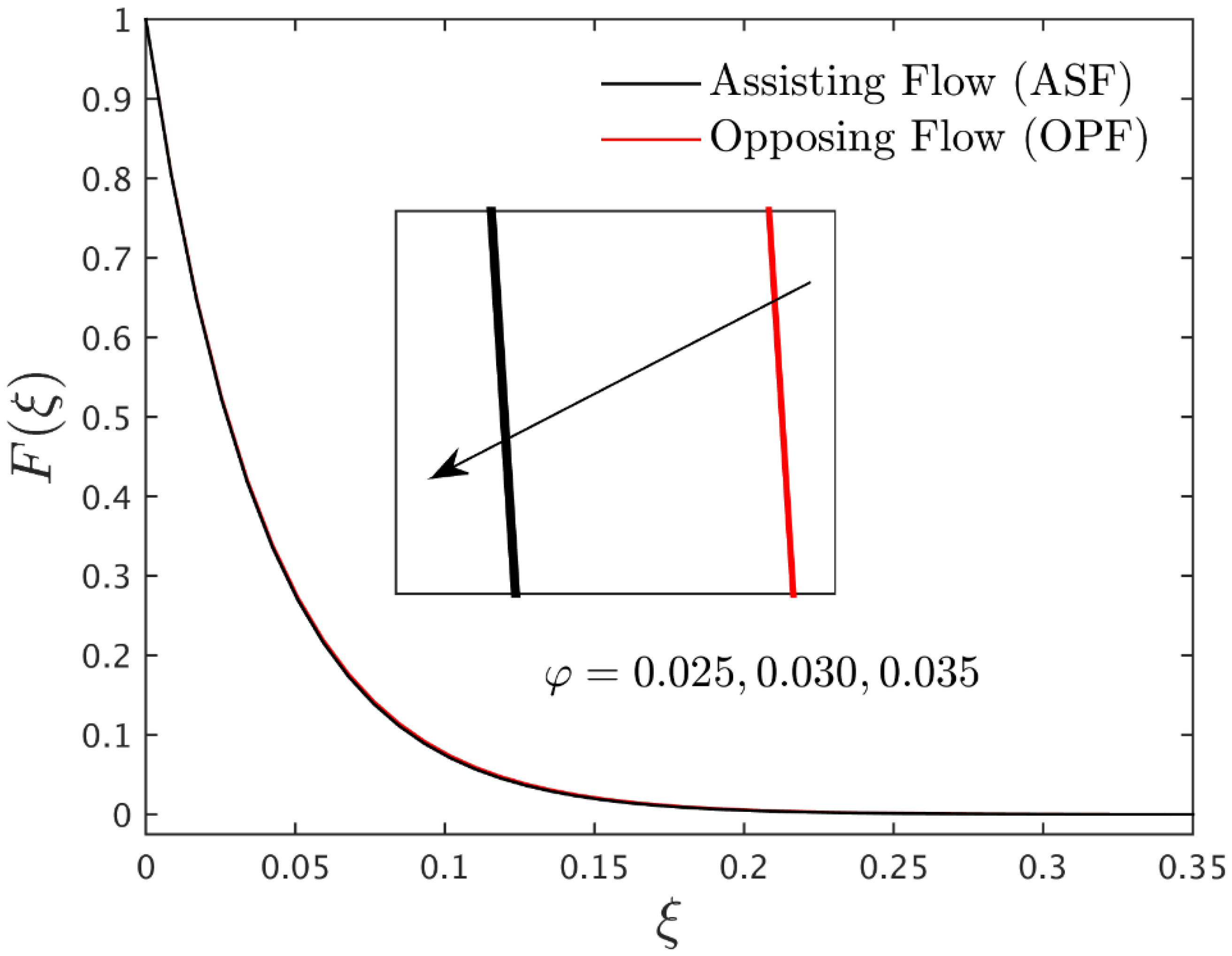
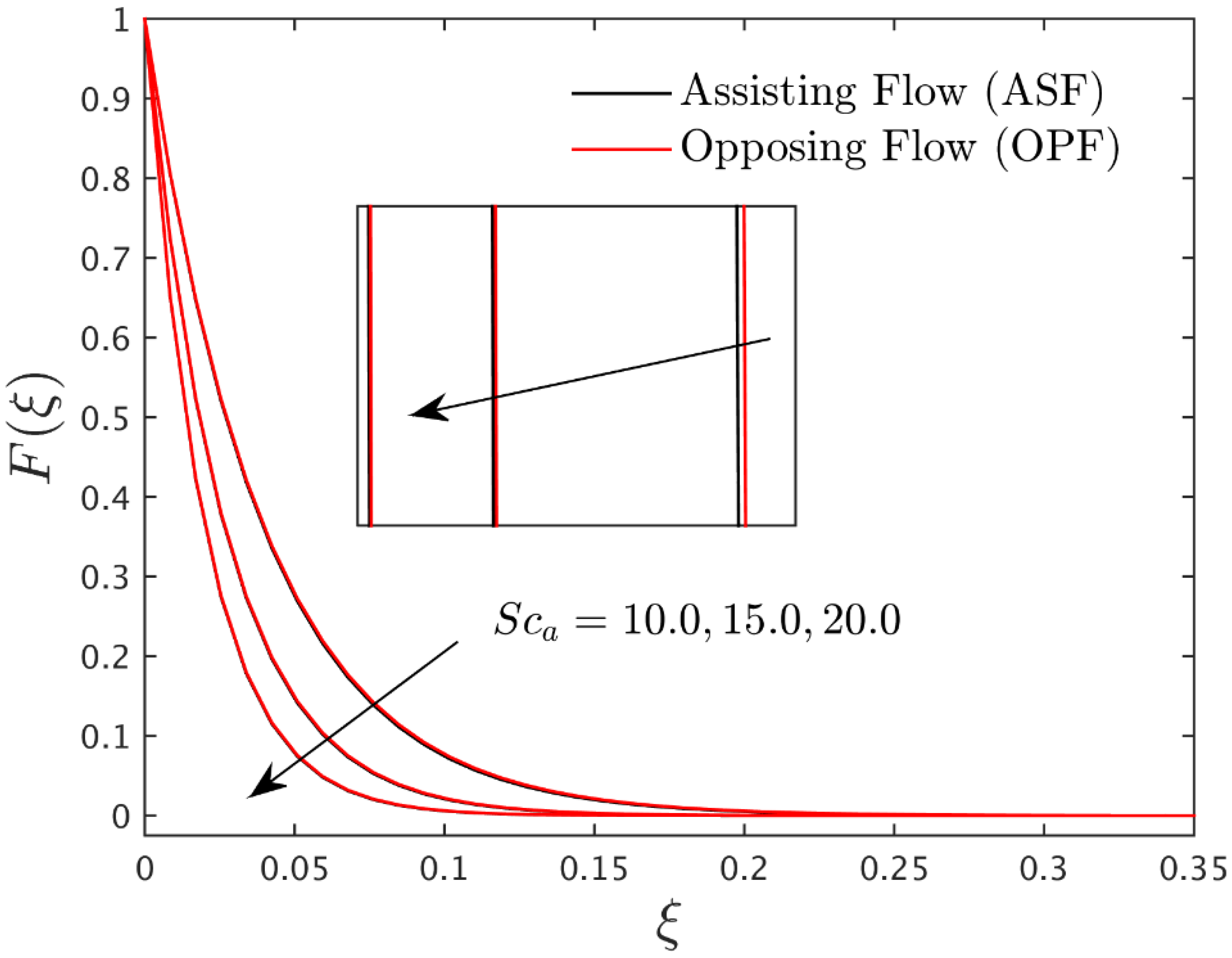
4.4. Interpretation of Gradients in Terms of Bar Graphs
5. Final Remarks
- The velocity profile enhances for both ASF and OPF due to the higher impact of the radius curvature parameter; however, for the temperature and concentration profiles, a decreasing behavior is noticed.
- For increasing values of nanoparticle volume fraction, the temperature profile escalates, while velocity and concentration profiles decelerate for ASF and OPF.
- For ASF as well as OPF, the temperature profile significantly increases by incorporating the radiation parameter.
- With rising impact of the slip parameter, the shear stress output is smaller for the case of ASF as compared to the OPF.
- The heat transport rate improves by increasing the radiation parameter and radius of curvature parameter.
- The Arrhenius function factor, which appears in the activation energy parameter, causes the mass distribution to improve. However, as the reaction rate parameter improves, the mass distribution steadily decreases.
Author Contributions
Funding
Data Availability Statement
Acknowledgments
Conflicts of Interest
Nomenclature
| Radius of curvature (m) | |
| Spatial or Curvilinear coordinates (m) | |
| Velocity components (m/s) | |
| Radiative heat flux | |
| Wall stretching velocity (m/s) | |
| Slip velocity (m/s) | |
| Positive arbitrary constant (1/s) | |
| Slip characteristic length (m) | |
| Mass transpiration velocity (m/s) | |
| Ambient temperature (K) | |
| Ambient concentration | |
| Temperature of the wall surface (K) | |
| Temperature of the nanofluid (K) | |
| Concentration of the nanofluid | |
| Pressure (Pa or N/m2) | |
| Specific heat at constant pressure (J/Kg. K) | |
| Thermal conductivity (W/(m. K)) | |
| Mass diffusion coefficient | |
| Activation energy (W/m) | |
| Chemical reaction rate | |
| Mass suction/injection parameter | |
| Mean absorption coefficient (1/m) | |
| Dimensionless velocity | |
| Prandtl number | |
| Dimensionless concentration | |
| Radius of curvature parameter | |
| Schmidt number | |
| Chemical reaction rate parameter | |
| Activation energy parameter | |
| Grashof number | |
| Local Nusselt number | |
| Skin friction coefficient | |
| Local Reynolds number | |
| Dimensionless temperature | |
| Dimensionless pressure | |
| Radiation parameter | |
| Relative factor of the power-law index | |
| Sherwood number | |
| Heat flux | |
| Greek symbols | |
| Stefan-Boltzmann constant (W/(m2. K4)) | |
| Kinematic viscosity (m2/s) | |
| Thermal expansion coefficient (1/K) | |
| Density (kg/m3) | |
| Dynamic viscosity (N. s/m2) | |
| Solid nanoparticle volume fraction | |
| Pseudo-similarity variable | |
| Velocity slip parameter | |
| Temperature difference parameter | |
| Mixed convection parameter | |
| Mass flux | |
| Shear stress | |
| Acronyms | |
| Cu | Copper |
| Bvp4c | Boundary value problem of fourth-order |
| CuO | Copper oxide |
| MHD | Magneto-hydrodynamics |
| MgO | Magnesium oxide |
| Au | Gold |
| ZnO | Zinc Oxide |
| Al2O3 | Alumina |
| H2O | Water |
| ASF | Assisting flow |
| 2D | Two-dimensional |
| OPF | Opposing flow |
| MBLT | Momentum boundary layer thickness |
| Subscripts | |
| Regular based-fluid | |
| Solid nanoparticles | |
| Nanofluid | |
| Wall boundary condition | |
| Far-field condition | |
| Superscript | |
| ‘ | Derivative with respect to |
References
- Choi, S.U.S.; Eastman, J.A. Enhancing Thermal Conductivity of Fluids with Nanoparticles; Technical Report; Argonne National Lab.: Lemont, IL, USA, 1995. [Google Scholar]
- Eastman, J.A.; Choi, S.U.S.; Li, S.; Yu, W.; Thompson, L.J. Anomalously increased effective thermal conductivities of ethylene glycol-based nanofluids containing copper nanoparticles. Appl. Phys. Lett. 2001, 78, 718–720. [Google Scholar] [CrossRef]
- Ali, B.; Ahammad, N.A.; Awan, A.U.; Oke, A.S.; Tag-El Din, E.M.; Shah, F.A.; Majeed, S. The dynamics of water-based nanofluid subject to the nanoparticle’s radius with a significant magnetic field: The case of rotating micropolar fluid. Sustainability 2022, 14, 10474. [Google Scholar] [CrossRef]
- Vajravelu, K.; Prasad, K.V.; Lee, J.; Lee, C.; Pop, I.; Van Gorder, R.A. Convective heat transfer in the flow of viscous Ag–water and Cu–water nanofluids over a stretching surface. Int. J. Therm. Sci. 2011, 50, 843–851. [Google Scholar] [CrossRef]
- Khan, U.; Zaib, A.; Shah, Z.; Baleanu, D.; Sherif, E.S.M. Impact of magnetic field on boundary-layer flow of Sisko liquid comprising nanomaterials migration through radially shrinking/stretching surface with zero mass flux. J. Mater. Res. Technol. 2020, 9, 3699–3709. [Google Scholar] [CrossRef]
- Makinde, O.D.; Aziz, A. Boundary layer flow of a nanofluid past a stretching sheet with a convective boundary condition. Int. J. Therm. Sci. 2011, 50, 1326–1332. [Google Scholar] [CrossRef]
- Khan, M.; Khan, U. Stability analysis in the transient flow of Carreau fluid with non-linear radiative heat transfer and nanomaterials: Critical points. J. Mol. Liq. 2018, 272, 787–800. [Google Scholar]
- Roşca, N.S.; Pop, I. Unsteady boundary layer flow of a nanofluid past a moving surface in an external uniform free stream using Buongiorno’s model. Comp. Fluids 2014, 95, 49–55. [Google Scholar]
- Khan, U.; Shafiq, A.; Zaib, A.; Sherif, E.S.M.; Baleanu, D. MHD radiative blood flow embracing gold particles via a slippery sheet through an erratic heat sink/source. Mathematics 2020, 8, 1597. [Google Scholar] [CrossRef]
- Awan, A.U.; Akbar, A.A.; Hamam, H.; Gamaoun, F.; Tag-El Din, E.M.; Abdulrahman, A. Characterization of the induced magnetic field on third-grade micropolar fluid flow across an exponentially stretched sheet. Front. Phys. 2022, 10, 640. [Google Scholar]
- Yu, Y.; Madhukesh, J.K.; Khan, U.; Zaib, A.; Abdel-Aty, A.H.; Yahia, I.S.; Alqahtani, M.S.; Wang, F.; Galal, A.M. Nanoparticle Aggregation and Thermophoretic Particle Deposition Process in the Flow of Micropolar Nanofluid over a Stretching Sheet. Nanomaterials 2022, 12, 977. [Google Scholar] [CrossRef]
- Madhukesh, J.K.; Mansir, I.B.; Prasannakumara, B.C.; Khan, M.I.; Alharbi, K.A.M.; Abdelrahman, A.; Khan, M.; Ramesh, G.K.; Ahmed, A.E.S. Combined impact of Marangoni convection and thermophoretic particle deposition on chemically reactive transport of nanofluid flow over a stretching surface. Nanotechnol. Rev. 2022, 11, 2202–2214. [Google Scholar] [CrossRef]
- Chu, Y.M.; Khan, U.; Shafiq, A.; Zaib, A. Numerical simulations of time-dependent micro-rotation blood flow induced by a curved moving surface through conduction of gold particles with non-uniform heat sink/source. Arab. J. Sci. Eng. 2021, 46, 2413–2427. [Google Scholar] [CrossRef]
- Reddy, M.G.; Rani, S.; Kumar, K.G.; Seikh, A.H.; Rahimi-Gorji, M.; Sherif, E.S.M. Transverse magnetic flow over a Reiner–Philippoff nanofluid by considering solar radiation. Mod. Phys. Lett. B 2019, 33, 1950449. [Google Scholar] [CrossRef]
- Shamshuddin, M.D.; Mebarek-Oudina, F.; Salawu, S.O.; Shafiq, A. Thermophoretic movement transport of reactive Casson nanofluid on Riga plate surface with nonlinear thermal radiation and uneven heat sink/source. J. Nanofluids 2022, 11, 833–844. [Google Scholar] [CrossRef]
- Raza, J.; Mebarek-Oudina, F.; Ram, P.; Sharma, S. MHD flow of non-Newtonian molybdenum disulfide nanofluid in a converging/diverging channel with Rosseland radiation. Defect Diffus. Forum 2020, 401, 92–106. [Google Scholar] [CrossRef]
- Khan, U.; Zaib, A.; Ishak, A.; Waini, I.; Sherif, M.E.S.; Pop, I. Analysis of Jet wall flow and heat transfer conveying ZnO-SAE50 nano lubricants saturated in Darcy-Brinkman porous medium. Mathematics 2022, 10, 3201. [Google Scholar] [CrossRef]
- Kumar, R.; Bhattacharyya, A.; Seth, G.S.; Chamkha, A.J. Transportation of magnetite nanofluid flow and heat transfer over a rotating porous disk with Arrhenius activation energy: Fourth order Noumerov’s method. Chin. J. Phys. 2021, 69, 172–185. [Google Scholar] [CrossRef]
- Salahuddin, T.; Arshad, M.; Siddique, N.; Alqahtani, A.S.; Malik, M.Y. Thermophyical properties and internal energy change in Casson fluid flow along with activation energy. Ain Shams Eng. J. 2020, 11, 1355–1365. [Google Scholar] [CrossRef]
- Azam, M.; Abbas, Z. Recent progress in Arrhenius activation energy for radiative heat transport of cross nanofluid over a melting wedge. Propuls. Power Res. 2021, 10, 383–395. [Google Scholar] [CrossRef]
- Khan, M.I.; Alzahrani, F. Binary chemical reaction with activation energy in dissipative flow of non-Newtonian nanomaterial. J. Theor. Comput. Chem. 2020, 19, 2040006. [Google Scholar] [CrossRef]
- Abdelmalek, Z.; Mahanthesh, B.; Basir, M.F.M.; Imtiaz, M.; Mackolil, J.; Khan, N.S.; Nabwey, H.A.; Tlili, I. Mixed radiated magneto Casson fluid flow with Arrhenius activation energy and Newtonian heating effects: Flow and sensitivity analysis. Alex. Eng. J. 2020, 59, 3991–4011. [Google Scholar] [CrossRef]
- Shah, S.A.A.; Ahammad, N.A.; Ali, B.; Guedri, K.; Awan, A.U.; Gamaoun, F.; Tag-El Din, E.M. Significance of bio-convection, MHD, thermal radiation and activation energy across Prandtl nanofluid flow: A case of stretching cylinder. Int. Commun. Heat Mass Transf. 2022, 137, 106299. [Google Scholar] [CrossRef]
- Tayyab, M.; Siddique, I.; Jarad, F.; Ashraf, M.K.; Ali, B. Numerical solution of 3D rotating nanofluid flow subject to Darcy-Forchheimer law, bio-convection and activation energy. S. Afr. J. Chem. Eng. 2022, 40, 48–56. [Google Scholar] [CrossRef]
- Bataller, R.C. Radiation effects in the Blasius flow. Appl. Math. Comput. 2008, 198, 333–338. [Google Scholar]
- Ishak, A. Thermal boundary layer flow over a stretching sheet in a micropolar fluid with radiation effect. Meccanica 2010, 45, 363–373. [Google Scholar] [CrossRef]
- Magyari, E.; Pantokratoras, A. Note on the effect of thermal radiation in the linearized Rosseland approximation on the heat transfer characteristics of various boundary layer flows. Int. Commun. Heat Mass Transf. 2011, 38, 554–556. [Google Scholar] [CrossRef]
- Khan, U.; Waini, I.; Zaib, A.; Ishak, A.; Pop, I. MHD mixed convection hybrid nanofluids flow over a permeable moving inclined flat plate in the presence of thermophoretic and radiative heat flux effects. Mathematics 2022, 10, 1164. [Google Scholar] [CrossRef]
- Shampine, L.F.; Gladwell, I.; Thompson, S. Solving ODEs with MATLAB; Cambridge University Press: Cambridge, UK, 2003. [Google Scholar]
- Sarfraz, M.; Khan, M. Significance of ethylene glycol-based CNT Homann nanofluid flow over a biaxially stretching surface. Waves Random Complex Media 2022, 32, 1–15. [Google Scholar] [CrossRef]
- Khan, M.; Sarfraz, M.; Ahmed, A.; Malik, M.Y.; Alqahtani, A.S. Study of engine-oil based CNT nanofluid flow on a rotating cylinder with viscous dissipation. Phys. Scr. 2021, 96, 075005. [Google Scholar] [CrossRef]
- Khan, U.; Zaib, A.; Ishak, A.; Bakar, S.A.; Sherif, E.S.M.; Muhammad, N. Radiation effect on three-dimensional stagnation point flow involving copper-aqueous titania hybrid nanofluid induced by a non-Fourier heat flux over a horizontal plane surface. Phys. Scr. 2022, 97, 015002. [Google Scholar] [CrossRef]
- Sanni, K.M.; Asghar, S.; Jalil, M.; Okechi, N.F. Flow of viscous fluid along a nonlinearly stretching curved surface. Results Phys. 2017, 7, 1–4. [Google Scholar] [CrossRef] [Green Version]
- Abbas, Z.; Naveed, M.; Sajid, M. Heat transfer analysis for stretching flow over a curved surface with magnetic field. J. Eng. Thermophys. 2013, 22, 337–345. [Google Scholar] [CrossRef]



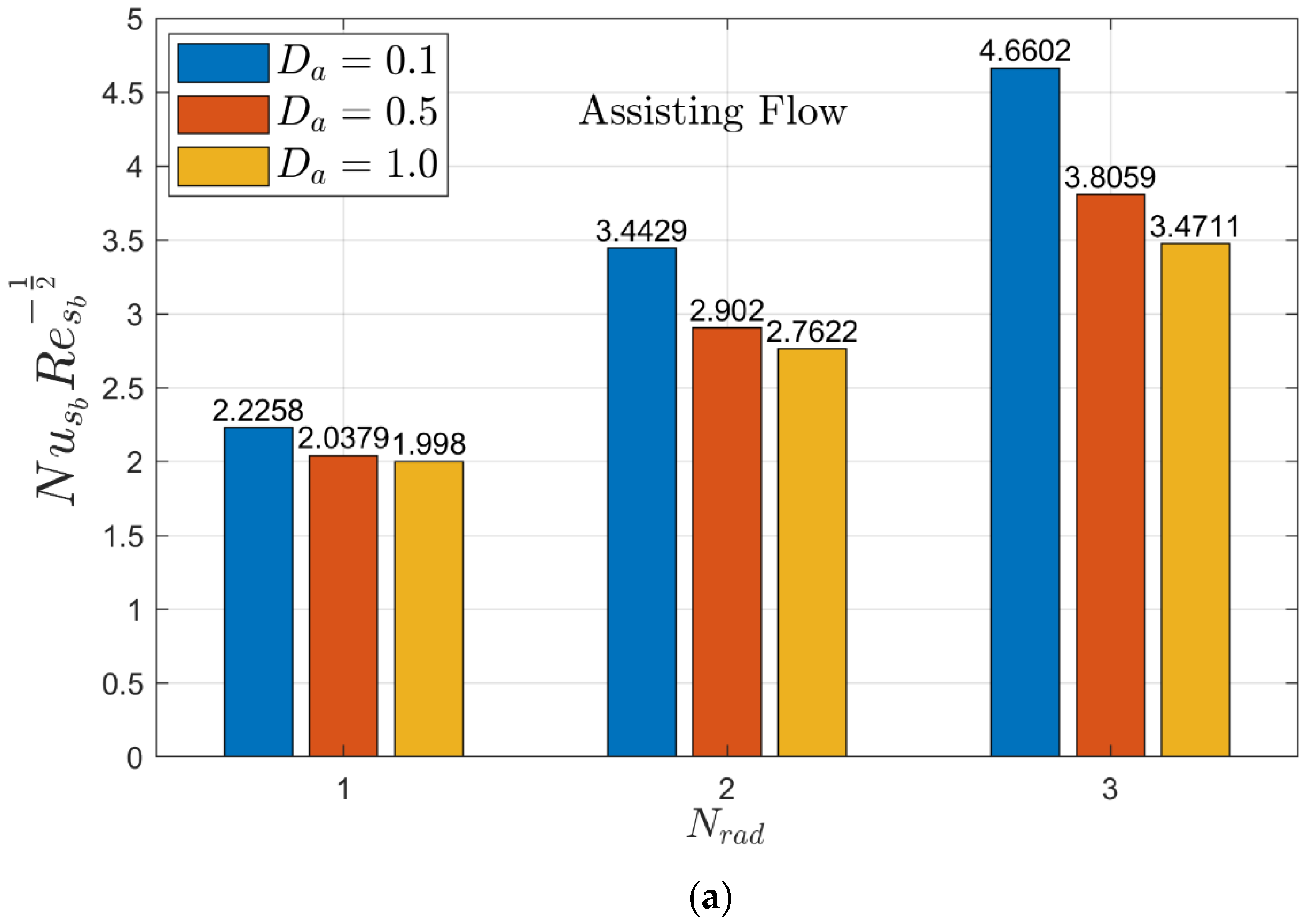


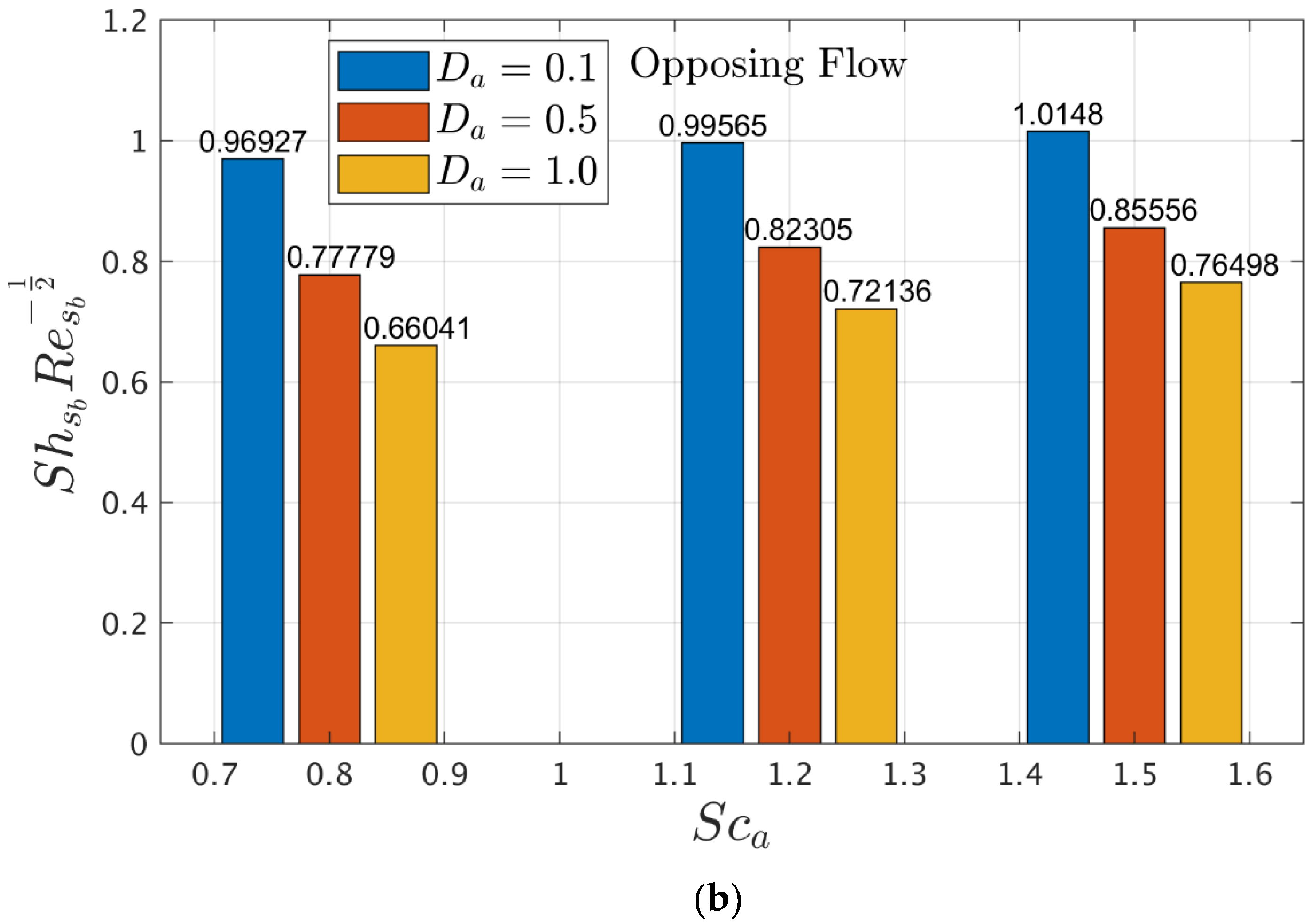
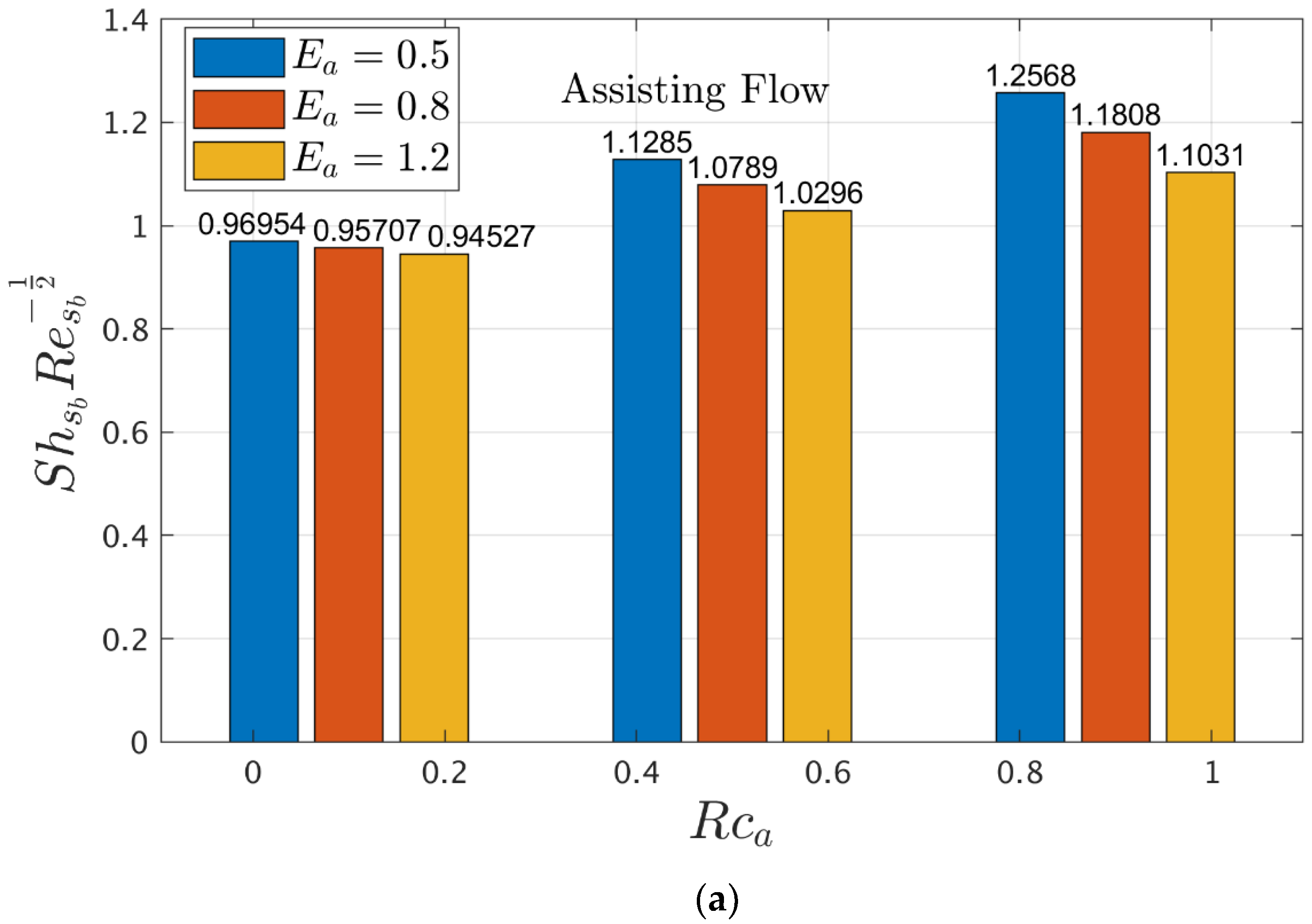
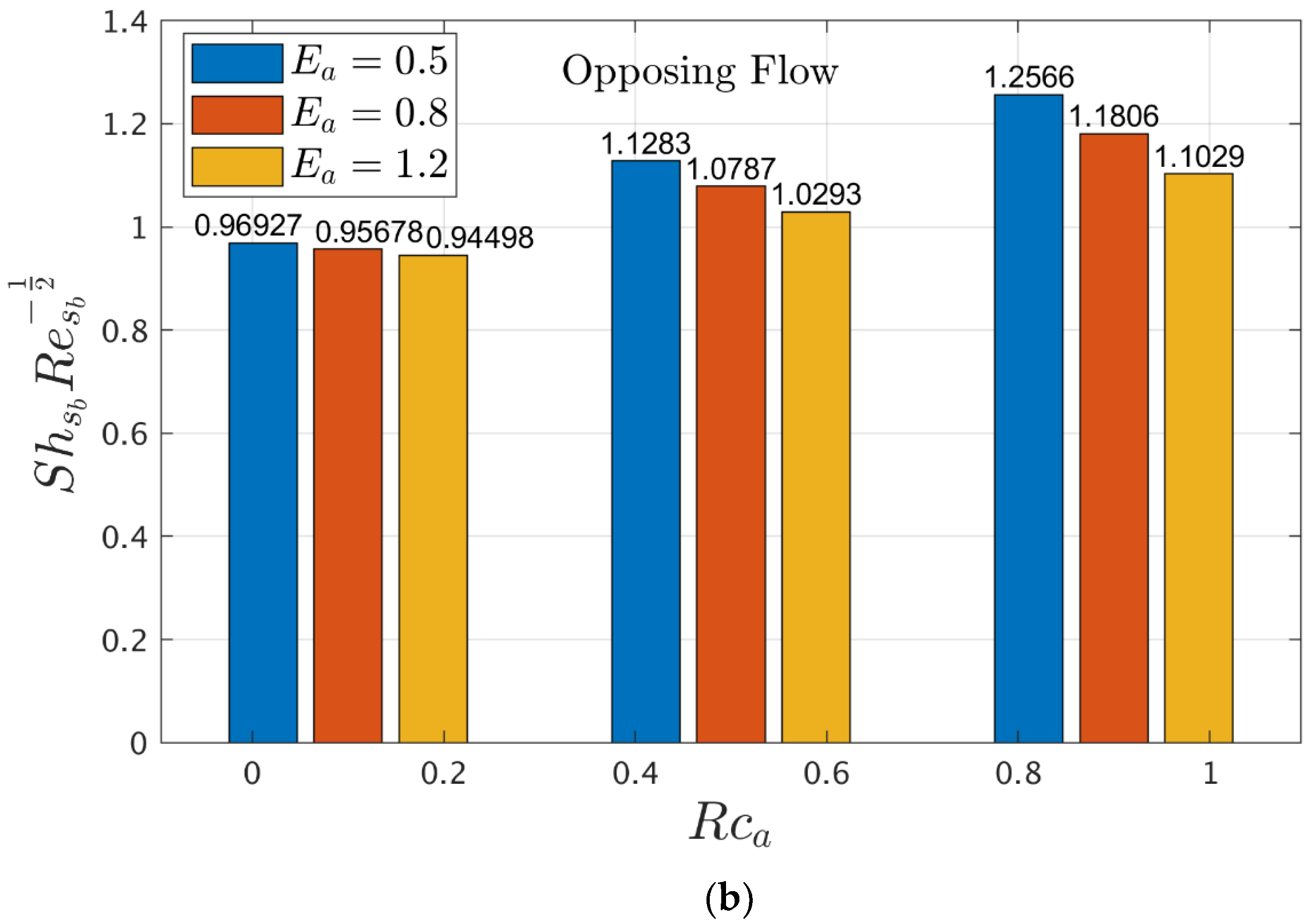
| Properties | Alumina (Al2O3) | Water (H2O) |
|---|---|---|
| 25.5 | 21 | |
| 40 | 0.613 | |
| 3970 | 997.1 | |
| 765 | 4179 | |
| Pr | - | 6.2 |
| Sanni et al. [33] | Zaheer et al. [34] | Present Results | |
|---|---|---|---|
| 5 | 1.1507 | 1.1576 | 1.1507 |
| 10 | 1.0734 | 1.0735 | 1.0734 |
| 20 | 1.0355 | 1.0356 | 1.0356 |
| 30 | 1.0235 | 1.0235 | 1.0235 |
| 40 | 1.0176 | 1.0176 | 1.0175 |
| 50 | 1.0140 | 1.0141 | 1.0141 |
| 100 | 1.0070 | 1.0070 | 1.0070 |
| 200 | 1.0036 | 1.0036 | 1.0035 |
| 1000 | 1.0008 | 1.0008 | 1.0008 |
| 1.0000 | 1.0000 | 1.0000 |
Publisher’s Note: MDPI stays neutral with regard to jurisdictional claims in published maps and institutional affiliations. |
© 2022 by the authors. Licensee MDPI, Basel, Switzerland. This article is an open access article distributed under the terms and conditions of the Creative Commons Attribution (CC BY) license (https://creativecommons.org/licenses/by/4.0/).
Share and Cite
Khan, U.; Zaib, A.; Madhukesh, J.K.; Elattar, S.; Eldin, S.M.; Ishak, A.; Raizah, Z.; Waini, I. Features of Radiative Mixed Convective Heat Transfer on the Slip Flow of Nanofluid Past a Stretching Bended Sheet with Activation Energy and Binary Reaction. Energies 2022, 15, 7613. https://doi.org/10.3390/en15207613
Khan U, Zaib A, Madhukesh JK, Elattar S, Eldin SM, Ishak A, Raizah Z, Waini I. Features of Radiative Mixed Convective Heat Transfer on the Slip Flow of Nanofluid Past a Stretching Bended Sheet with Activation Energy and Binary Reaction. Energies. 2022; 15(20):7613. https://doi.org/10.3390/en15207613
Chicago/Turabian StyleKhan, Umair, Aurang Zaib, Javali K. Madhukesh, Samia Elattar, Sayed M. Eldin, Anuar Ishak, Zehba Raizah, and Iskandar Waini. 2022. "Features of Radiative Mixed Convective Heat Transfer on the Slip Flow of Nanofluid Past a Stretching Bended Sheet with Activation Energy and Binary Reaction" Energies 15, no. 20: 7613. https://doi.org/10.3390/en15207613







